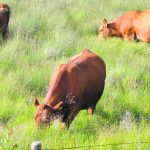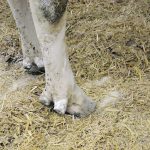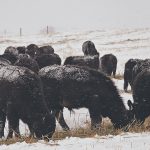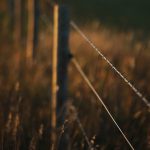Alberta Beef Producers sees non-refundable checkoff as long-term goal, but says it will take a cautious approach
The topic of check-off refunds has long been a key conversation in Alberta’s beef industry. Check-off dollars are intended to promote and support the cattle industry in Alberta, but about $3.2 million is taken out of Alberta Beef Producers’ budget each year due to refund requests from Alberta producers. Of the $4.50 per head check-off […] Read moreBeef cattle

JBS backs off net-zero pledge
SAO PAULO, Brazil (Reuters) — JBS, the world’s largest meat packer, became in 2021 the first of its peers to commit to cutting or offsetting all its emissions by 2040, and to ending illegal deforestation across its long supply chain that starts in the heart of the Brazilian Amazon. It used terms such as “commitment” […] Read more

Beef consumption increases slightly from 2022
The Canadian Roundtable for Sustainable Beef conducts a new consumer survey to help promote the cattle industry
Glacier FarmMedia – A few more Canadians eat beef now than they did in 2022, according to a survey from the Canadian Roundtable for Sustainable Beef. CRSB executive director Monica Hadarits told the Western Canada Conference on Soil Health and Grazing late last year that consumer research conducted last July found a positive outlook about […] Read more
New docuseries highlights cattle’s climate role
A new documentary from the U.S. compares adaptive multi-paddock grazing to what producers have done in the past
Glacier FarmMedia – A new docuseries out of the United States examines adaptive multi-paddock grazing versus conventional grazing. Peter Byck, a documentarian and professor at Arizona State University, talked about the docuseries Roots So Deep (you can see the devil down there) at the last year’s Western Canada Conference on Soil Health and Grazing. The […] Read more
Managing lameness in cattle can mean tough decisions
In cow calf production, lameness is second only to reproduction for culling criteria. It impacts all levels of the production cycle, and in the long term, it can become an animal welfare issue. Cow-calf producers must prevent and treat lameness and provide an area with feed and water close by where convalescence can occur. If […] Read more

Cameras can improve winter calving
Putting a camera in the barn takes the stress out of calving, provides peace of mind and makes checking cattle easier
Glacier FarmMedia – Winter is in full force and freezing temperatures, large dumps of snow and short days can make winter calving a challenge for seed stock producers. However, technologies such as calving cameras can help make it much easier by saving time and labour. For many, it has become a necessary tool on their […] Read more
Research funding announced for Sask. beef, forage projects
SASKATOON — Saskatchewan and Ottawa today announced $6.9 million in livestock and forage-related research funding for 2025. Provincial agriculture minister Daryl Harrison told the Saskatchewan Beef Industry conference that funding from industry partners will push that to $7.2 million. The money flows through the Agriculture Development Fund. “Innovation is the key to staying competitive and […] Read more

The times — and technology — are a-changin’ for agriculture
Every generation faces different obstacles and finds different opportunities — and often the opportunities and growth are closely related to the obstacles. Ron Clarke’s Vet Advice column in the January issue of Canadian Cattleman is a perfect example of this. He writes about the invention of barbed wire and how it ended open-range grazing. It’s […] Read more

Delayed U.S. tariffs support feeder complex
Fears that the U.S. would implement a tariff on feeder cattle ignited concerns that the market would drop sharply
For the week ending Jan. 25, western Canadian feeder markets were quite variable, trading $5-$10 on either side of unchanged compared to seven days earlier. Prices for calves weighing less than 600 pounds were variable as adverse weather resulted in risk discount in certain regions. Producer selling increased over the past couple of weeks, and […] Read moreCanfax report
This cattle market information is selected from the weekly report from Canfax, a division of the Canadian Cattle Association. More market information, analysis and statistics are available by becoming a Canfax subscriber by calling 403-275-5110 or at www.canfax.ca. Steers, heifers down The fed market continues to be hot, rising by $28 per hundredweight over the […] Read more




